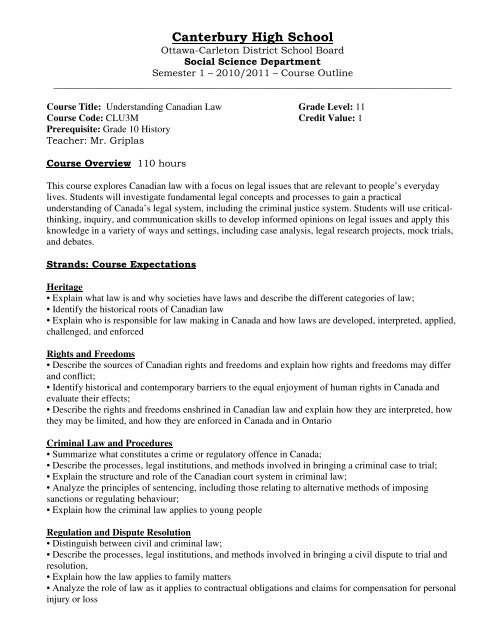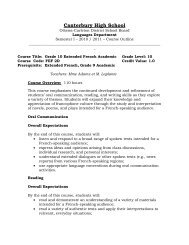Grade 11 Understanding Canadian Law, CLU3M - Canterbury High ...
Grade 11 Understanding Canadian Law, CLU3M - Canterbury High ...
Grade 11 Understanding Canadian Law, CLU3M - Canterbury High ...
Create successful ePaper yourself
Turn your PDF publications into a flip-book with our unique Google optimized e-Paper software.
<strong>Canterbury</strong> <strong>High</strong> School<br />
Ottawa-Carleton District School Board<br />
Social Science Department<br />
Semester 1 – 2010/20<strong>11</strong> – Course Outline<br />
__________________________________________________________________________________<br />
Course Title: <strong>Understanding</strong> <strong>Canadian</strong> <strong>Law</strong> <strong>Grade</strong> Level: <strong>11</strong><br />
Course Code: <strong>CLU3M</strong> Credit Value: 1<br />
Prerequisite: <strong>Grade</strong> 10 History<br />
Teacher: Mr. Griplas<br />
Course Overview <strong>11</strong>0 hours<br />
This course explores <strong>Canadian</strong> law with a focus on legal issues that are relevant to people’s everyday<br />
lives. Students will investigate fundamental legal concepts and processes to gain a practical<br />
understanding of Canada’s legal system, including the criminal justice system. Students will use criticalthinking,<br />
inquiry, and communication skills to develop informed opinions on legal issues and apply this<br />
knowledge in a variety of ways and settings, including case analysis, legal research projects, mock trials,<br />
and debates.<br />
Strands: Course Expectations<br />
Heritage<br />
• Explain what law is and why societies have laws and describe the different categories of law;<br />
• Identify the historical roots of <strong>Canadian</strong> law<br />
• Explain who is responsible for law making in Canada and how laws are developed, interpreted, applied,<br />
challenged, and enforced<br />
Rights and Freedoms<br />
• Describe the sources of <strong>Canadian</strong> rights and freedoms and explain how rights and freedoms may differ<br />
and conflict;<br />
• Identify historical and contemporary barriers to the equal enjoyment of human rights in Canada and<br />
evaluate their effects;<br />
• Describe the rights and freedoms enshrined in <strong>Canadian</strong> law and explain how they are interpreted, how<br />
they may be limited, and how they are enforced in Canada and in Ontario<br />
Criminal <strong>Law</strong> and Procedures<br />
• Summarize what constitutes a crime or regulatory offence in Canada;<br />
• Describe the processes, legal institutions, and methods involved in bringing a criminal case to trial;<br />
• Explain the structure and role of the <strong>Canadian</strong> court system in criminal law;<br />
• Analyze the principles of sentencing, including those relating to alternative methods of imposing<br />
sanctions or regulating behaviour;<br />
• Explain how the criminal law applies to young people<br />
Regulation and Dispute Resolution<br />
• Distinguish between civil and criminal law;<br />
• Describe the processes, legal institutions, and methods involved in bringing a civil dispute to trial and<br />
resolution,<br />
• Explain how the law applies to family matters<br />
• Analyze the role of law as it applies to contractual obligations and claims for compensation for personal<br />
injury or loss
Methods of Legal Inquiry<br />
• Use research methods appropriately to gather, organize, and synthesize information;<br />
• evaluate the credibility of sources;<br />
• Demonstrate an understanding of the dynamic nature of law, including the way in which it evolves in<br />
response to technology and changes in societal values;<br />
• Explain, discuss, and interpret legal issues, orally and in writing, using a variety of formats<br />
Units:<br />
Unit 1<br />
Unit 2<br />
Unit 3<br />
Unit 4<br />
Unit 5<br />
Heritage<br />
Rights and Freedoms<br />
Criminal <strong>Law</strong> and Procedures<br />
Regulation and Dispute Resolution<br />
Methods of Legal Inquiry<br />
Teaching Strategies:<br />
Teacher demonstrations Brainstorming Small group work<br />
Multimedia Investigative research Written assignments<br />
Presentations Listening Discussion/ reflection<br />
Debates<br />
Assessment and Evaluation Strategies<br />
Written Tests<br />
Written assignments<br />
Creative representations<br />
Summative Assignment<br />
Rubrics<br />
Quizzes<br />
Individual research project/essay<br />
Final Examination<br />
Evaluation Summary:<br />
70% of the grade will be based on evaluations conducted throughout the course.<br />
Evaluations are based on the four learning categories:<br />
1. Knowledge/<strong>Understanding</strong>: • 17.5% unit tests, independent research assignment (process), assignments<br />
2. Thinking/Inquiry • 17.5% unit tests, independent research assignment (process), assignments<br />
3. Communication • 17.5% unit tests, independent research assignment (process), assignments<br />
4. Application • 17.5% unit tests, independent research assignment (process), assignments<br />
30% of the final grade in all courses will be based on a final summative evaluation that will be<br />
administered at or towards the end of the course.<br />
• Summative Evaluation: 10% - Independent research assignment (argumentative essay)<br />
• Final Examination: 20% - An examination is a formal test done during the school’s official examination<br />
period in Janaury. It will address topics examined throughout the course. Unit tests during the course<br />
should prepare students for the examination.<br />
References<br />
www.edu.gov.on.ca/eng/curriculum/secondary/<br />
Student Resources / Texts<br />
The textbook we will be using is All About <strong>Law</strong> (Fifth Edition). Textbooks will be collected at the end of<br />
the course. Damaged or lost texts will be the responsibility of the students. They will be charged the<br />
current replacement cost of the book, which is $92.
















